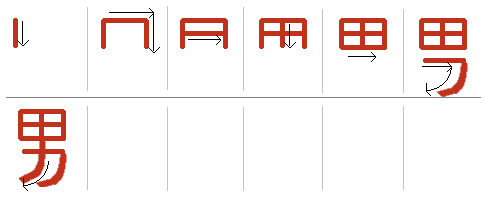You can practice Hanja by downloading a Hanja list for free and uploading to our app! Check our Hanja Lists and many of our other free tailored lists here. Check out how it looks on our app in this YouTube video.
—
In this lesson, you will learn common Hanja characters that refer to people.
——————————————————————————————————
.
人 = 인 = Person
(Korean name: 사람 인)
Often used as the last letter (character) of a word to mean “person.” Due to its simplicity and common meaning, this character can be recognized by all Korean people. It is commonly taught by trying to imagine the character as a walking person.
 Common Words using this Character:
Common Words using this Character:
外국人 = foreigner
시人 = poet
부人 = one’s wife
개人 = person(al)
人간 = man, human, mankind
小人 = a child (small person)
人사 = a greeting
人기 = popularity
——————————————————————————————————
.
子 = 자 = Person
(Korean name: 아들 자)
Technically called “son 자,” but this character can be found in words where the meaning is male or female. 子 can also be seen as a part of other, more complicated characters. For example, 學 (learning) and 字 (writing) have 子 contained within them.
 Common Words using this Character:
Common Words using this Character:
여子 = girl
남子 = man
子식 = children
子녀 = sons and daughters
의子 = chair
모子 = hat
탁子 = table
——————————————————————————————————
.
父 = 부 = Father
(Korean name: 아비 부)
You probably won’t see this character anywhere in your daily life, but it is one of the simplest and most recognized Hanja characters in Korea.
 Common Words using this Character:
Common Words using this Character:
父모님 = parents
父친 = father
학父모 = parents of children at school
——————————————————————————————————
.
母 = 모 = Mother
(Korean name: 어미 모)
You probably won’t see this character anywhere in your daily life, but it is one of the simplest and most recognized Hanja characters in Korea. The stroke order of this one seems to break the rules of stroke-order, as it is not how I would intuitively do it.
 Common Words using this Character:
Common Words using this Character:
父母님 = parents
학父母 = parents of children at school
母국어 = mother tongue
고母 = father’s sister (aunt on father’s side)
이母 = mother’s sister (aunt on mother’s side)
——————————————————————————————————
.
男 = 남 = Man, Male
(Korean word: 사내 남)
Every Korean is expected to be able to recognize this character. I have seen many public restrooms in Korea with only Hanja characters on the door to represent the appropriate room for each gender (without any pictures, or other words).
Notice that you should completely finish with the square box on the top before starting to draw the lower part of the character. Even though it looks like the line in the middle of the upper box is connected to the long line at the bottom, they are not connected.
 Common Words using this Character:
Common Words using this Character:
男子 = man
男성 = male
男녀 = men and women
장男 = oldest son
男동생 = younger brother
男편 = husband
 ——————————————————————————————————
——————————————————————————————————
.
女 = 여/녀 =Woman, Female
(Korean name: 계집 여/녀)
As with 男, every Korean is expected to be able to recognize this character.
Notice that there are two ways to pronounce this character in Korean – and its pronunciation depends on the location of the character within a word. Typically, when a word begins with “女” it is pronounced as “여.” When the character is found anywhere but the beginning of the word, it is pronounced as “녀.”
 Common Words using this Character:
Common Words using this Character:
女子 = woman
女성 = female
女신 = goddess
男女 = men and women
女동생 = younger sister
子女 = sons and daughters
소女 = a young girl
——————————————————————————————————
That’s it for this lesson!
Okay, I got it! Take me to the next lesson! Or,
Click here for a PDF copy of all our Hanja lessons.

